刘洪波 雅思高分阅读真经 下
- 格式:pdf
- 大小:261.50 KB
- 文档页数:4
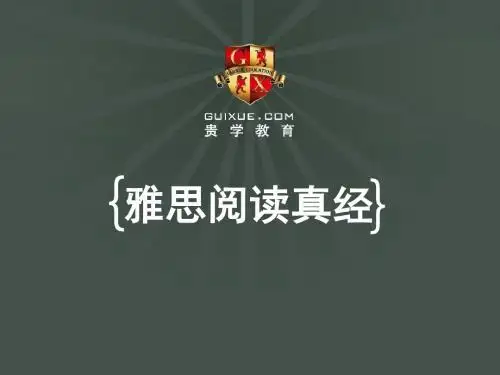

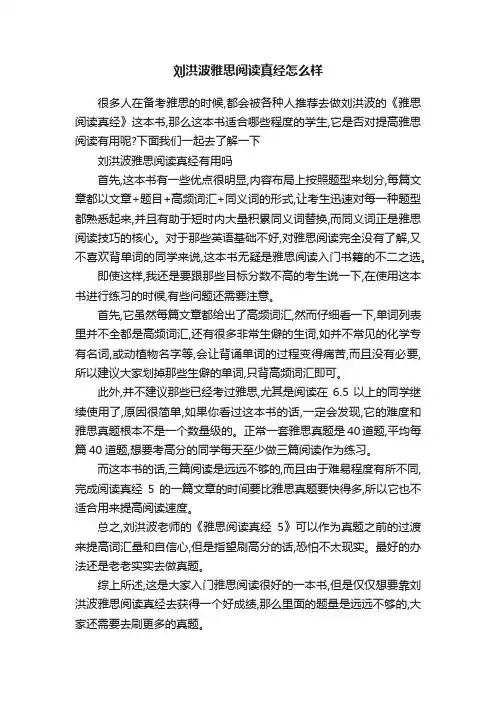
刘洪波雅思阅读真经怎么样很多人在备考雅思的时候,都会被各种人推荐去做刘洪波的《雅思阅读真经》这本书,那么这本书适合哪些程度的学生,它是否对提高雅思阅读有用呢?下面我们一起去了解一下刘洪波雅思阅读真经有用吗首先,这本书有一些优点很明显,内容布局上按照题型来划分,每篇文章都以文章+题目+高频词汇+同义词的形式,让考生迅速对每一种题型都熟悉起来,并且有助于短时内大量积累同义词替换,而同义词正是雅思阅读技巧的核心。
对于那些英语基础不好,对雅思阅读完全没有了解,又不喜欢背单词的同学来说,这本书无疑是雅思阅读入门书籍的不二之选。
即使这样,我还是要跟那些目标分数不高的考生说一下,在使用这本书进行练习的时候,有些问题还需要注意。
首先,它虽然每篇文章都给出了高频词汇,然而仔细看一下,单词列表里并不全都是高频词汇,还有很多非常生僻的生词,如并不常见的化学专有名词,或动植物名字等,会让背诵单词的过程变得痛苦,而且没有必要,所以建议大家划掉那些生僻的单词,只背高频词汇即可。
此外,并不建议那些已经考过雅思,尤其是阅读在6.5以上的同学继续使用了,原因很简单,如果你看过这本书的话,一定会发现,它的难度和雅思真题根本不是一个数量级的。
正常一套雅思真题是40道题,平均每篇40道题,想要考高分的同学每天至少做三篇阅读作为练习。
而这本书的话,三篇阅读是远远不够的,而且由于难易程度有所不同,完成阅读真经5的一篇文章的时间要比雅思真题要快得多,所以它也不适合用来提高阅读速度。
总之,刘洪波老师的《雅思阅读真经5》可以作为真题之前的过渡来提高词汇量和自信心,但是指望刷高分的话,恐怕不太现实。
最好的办法还是老老实实去做真题。
综上所述,这是大家入门雅思阅读很好的一本书,但是仅仅想要靠刘洪波雅思阅读真经去获得一个好成绩,那么里面的题量是远远不够的,大家还需要去刷更多的真题。
雅思阅读真经总纲刘洪波编著内容笔记阅读分为四种题型1、单词题(最简单:summary,流程图,填空,填句)2、句子题T/F和选择(中等难度:判断题和选择题)3、段落题Heading题(最难的,归纳中心思想)4、匹配题Matching题(有诀窍,并不难)前两种直拳,第3种还我漂亮拳,第4种面目全非掌无标题的文章很可能出标题题:末段+大意(把题干读一遍)!!雅思文章首段不是最重要段落,末段和第二段才是最重要的防盗版内容:Before群里去背单词During 助教讲部分内容After 模考如何提升阅读速度1扩大视距:把单词变为意群,不要默读2跳读和变速:重点读认识的单词,读得懂的读慢,读不懂的读快题干3类词汇如果任意打开一篇题干13道题不认识的有3个及以上,阅读词汇需补充三大类:主题词不认识没关系模板词如account /reference/ mention在阅读题干中就是“描述”之义,毫无意义,不需要去特别记(拿任何一本剑桥,把题干中所有不认识的词记下来)考点词如resemble考点词真经很重要,要背3类关键词Keywords问题:正确读题方法一定要慢且2遍找到Keyword 解题,不用再读题干三大类:眼球级朴素级普通动词、名词、形容词逻辑关系词并列(重大考点)、转折、因果总纲标注法:(做真题时做这个工作)画出题干和原文所有对应之处(同义替换)要用此法做真题练习精细理解力句子题段落题匹配题为什么不要精读?而要快速阅读和对比阅读首先就要背考点词,才能敏感地找到同义替换按总纲标注法做文章填空题考察的不是空格而是空格前后的同义替换如果找不到替换,关键词的本行和上下行,找不认识的词。
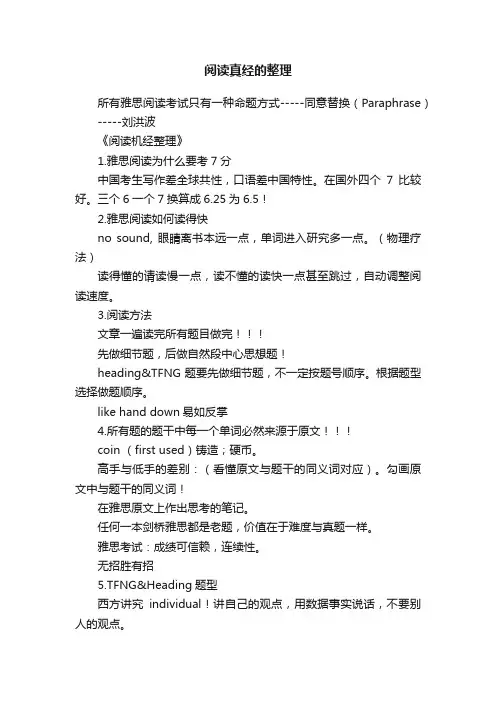
阅读真经的整理所有雅思阅读考试只有一种命题方式-----同意替换(Paraphrase)-----刘洪波《阅读机经整理》1.雅思阅读为什么要考7分中国考生写作差全球共性,口语差中国特性。
在国外四个7比较好。
三个6一个7换算成6.25为6.5!2.雅思阅读如何读得快no sound, 眼睛离书本远一点,单词进入研究多一点。
(物理疗法)读得懂的请读慢一点,读不懂的读快一点甚至跳过,自动调整阅读速度。
3.阅读方法文章一遍读完所有题目做完先做细节题,后做自然段中心思想题!heading&TFNG题要先做细节题,不一定按题号顺序。
根据题型选择做题顺序。
like hand down易如反掌4.所有题的题干中每一个单词必然来源于原文coin (first used)铸造;硬币。
高手与低手的差别:(看懂原文与题干的同义词对应)。
勾画原文中与题干的同义词!在雅思原文上作出思考的笔记。
任何一本剑桥雅思都是老题,价值在于难度与真题一样。
雅思考试:成绩可信赖,连续性。
无招胜有招5.TFNG&Heading题型西方讲究individual!讲自己的观点,用数据事实说话,不要别人的观点。
①:T 概率最高,首题不选NG,末题不选F。
首题对应文章前部分,最后一题NG比较高。
T3种出题题型:所有同义词改写80%是这种题,上写文总结归纳,文章中不同两句话前后照应的进行总结。
F2种出题题型:反义词设计,关系型驳斥(偷换主语之类)。
NG2种出题题型:出在原文中不相关联位置。
F题直接强烈的感觉,NG是一种可能性。
②Heading题:选上不选下(相邻两段都有某个意思时,选上不选下,因为每段都有承上启下句)读完某一自然段+下自然段首句选中心思想。
雅思阅读:词汇(内功)+招数+实战+机经(对方招数)阅读和听力旧题带新题----------------------------------------------分-----------------------------------------------------------------------------------割-----------------------------------------------------------------------线------------------------------------------《雅思阅读真经总纲》第2回阅读先看题,定位快寻觅真题的顺序:顺序1,各题型按原文顺序安排(<50%);顺序2,乱序组合。
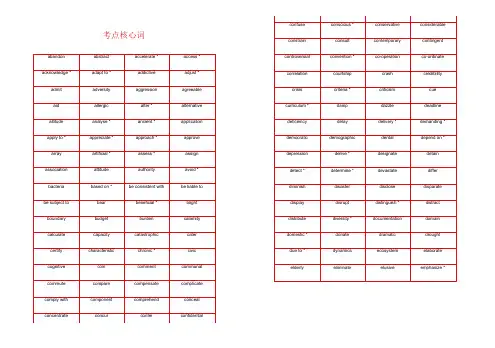
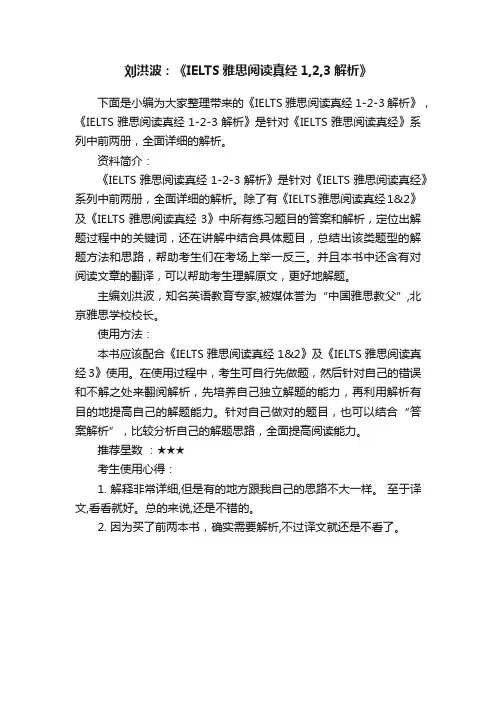
刘洪波:《IELTS雅思阅读真经1,2,3解析》
下面是小编为大家整理带来的《IELTS雅思阅读真经1-2-3解析》,《IELTS雅思阅读真经1-2-3解析》是针对《IELTS雅思阅读真经》系列中前两册,全面详细的解析。
资料简介:
《IELTS雅思阅读真经1-2-3解析》是针对《IELTS雅思阅读真经》系列中前两册,全面详细的解析。
除了有《IELTS雅思阅读真经1&2》及《IELTS雅思阅读真经3》中所有练习题目的答案和解析,定位出解题过程中的关键词,还在讲解中结合具体题目,总结出该类题型的解题方法和思路,帮助考生们在考场上举一反三。
并且本书中还含有对阅读文章的翻译,可以帮助考生理解原文,更好地解题。
主编刘洪波,知名英语教育专家,被媒体誉为“中国雅思教父”,北京雅思学校校长。
使用方法:
本书应该配合《IELTS雅思阅读真经1&2》及《IELTS雅思阅读真经3》使用。
在使用过程中,考生可自行先做题,然后针对自己的错误和不解之处来翻阅解析,先培养自己独立解题的能力,再利用解析有目的地提高自己的解题能力。
针对自己做对的题目,也可以结合“答案解析”,比较分析自己的解题思路,全面提高阅读能力。
推荐星数:★★★
考生使用心得:
1. 解释非常详细,但是有的地方跟我自己的思路不大一样。
至于译文,看看就好。
总的来说,还是不错的。
2. 因为买了前两本书,确实需要解析,不过译文就还是不看了。

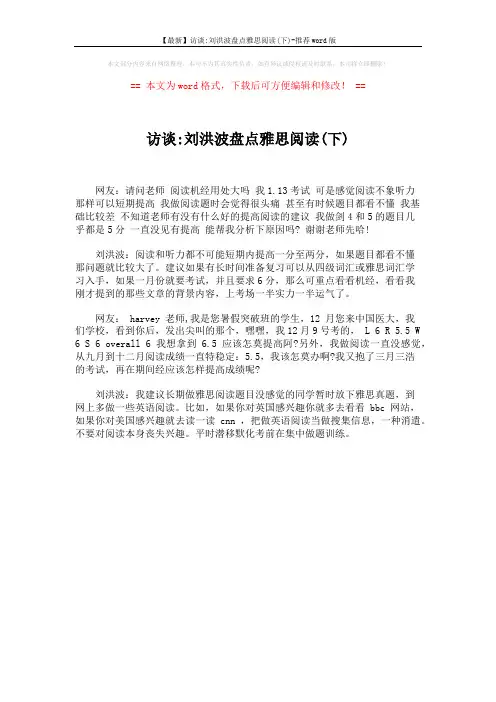
【最新】访谈:刘洪波盘点雅思阅读(下)-推荐word版
本文部分内容来自网络整理,本司不为其真实性负责,如有异议或侵权请及时联系,本司将立即删除!
== 本文为word格式,下载后可方便编辑和修改! ==
访谈:刘洪波盘点雅思阅读(下)
网友:请问老师阅读机经用处大吗我1.13考试可是感觉阅读不象听力
那样可以短期提高我做阅读题时会觉得很头痛甚至有时候题目都看不懂我基础比较差不知道老师有没有什么好的提高阅读的建议我做剑4和5的题目几
乎都是5分一直没见有提高能帮我分析下原因吗? 谢谢老师先哈!
刘洪波:阅读和听力都不可能短期内提高一分至两分,如果题目都看不懂
那问题就比较大了。
建议如果有长时间准备复习可以从四级词汇或雅思词汇学
习入手,如果一月份就要考试,并且要求6分,那么可重点看看机经,看看我
刚才提到的那些文章的背景内容,上考场一半实力一半运气了。
网友: harvey 老师,我是您暑假突破班的学生,12 月您来中国医大,我
们学校,看到你后,发出尖叫的那个,嘿嘿,我12月9号考的, L 6 R 5.5 W 6 S 6 overall 6 我想拿到 6.5 应该怎莫提高阿?另外,我做阅读一直没感觉,从九月到十二月阅读成绩一直特稳定:5.5,我该怎莫办啊?我又抱了三月三浩
的考试,再在期间经应该怎样提高成绩呢?
刘洪波:我建议长期做雅思阅读题目没感觉的同学暂时放下雅思真题,到
网上多做一些英语阅读。
比如,如果你对英国感兴趣你就多去看看 bbc 网站,如果你对美国感兴趣就去读一读 cnn ,把做英语阅读当做搜集信息,一种消遣。
不要对阅读本身丧失兴趣。
平时潜移默化考前在集中做题训练。
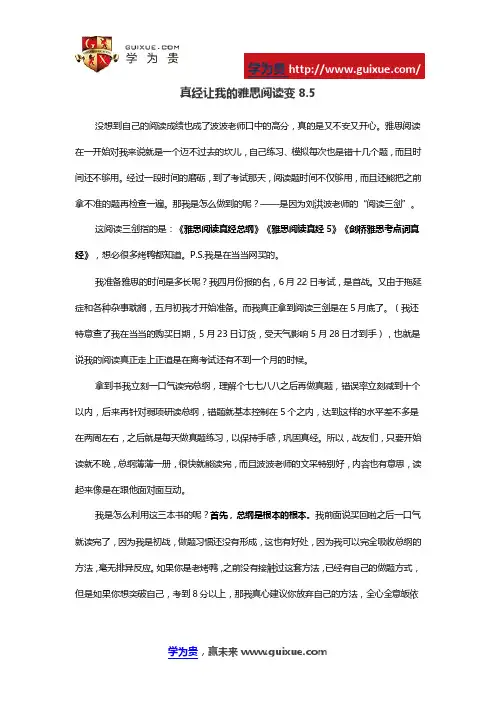
没想到自己的阅读成绩也成了波波老师口中的高分,真的是又不安又开心。
雅思阅读在一开始对我来说就是一个迈不过去的坎儿,自己练习、模拟每次也是错十几个题,而且时间还不够用。
经过一段时间的磨砺,到了考试那天,阅读题时间不仅够用,而且还能把之前拿不准的题再检查一遍。
那我是怎么做到的呢?——是因为刘洪波老师的“阅读三剑”。
这阅读三剑指的是:《雅思阅读真经总纲》《雅思阅读真经5》《剑桥雅思考点词真经》,想必很多烤鸭都知道。
P.S.我是在当当网买的。
我准备雅思的时间是多长呢?我四月份报的名,6月22日考试,是首战。
又由于拖延症和各种杂事耽搁,五月初我才开始准备。
而我真正拿到阅读三剑是在5月底了。
(我还特意查了我在当当的购买日期,5月23日订货,受天气影响5月28日才到手),也就是说我的阅读真正走上正道是在离考试还有不到一个月的时候。
拿到书我立刻一口气读完总纲,理解个七七八八之后再做真题,错误率立刻减到十个以内,后来再针对弱项研读总纲,错题就基本控制在5个之内,达到这样的水平差不多是在两周左右,之后就是每天做真题练习,以保持手感,巩固真经。
所以,战友们,只要开始读就不晚,总纲薄薄一册,很快就能读完,而且波波老师的文采特别好,内容也有意思,读起来像是在跟他面对面互动。
我是怎么利用这三本书的呢?首先,总纲是根本的根本。
我前面说买回啦之后一口气就读完了,因为我是初战,做题习惯还没有形成,这也有好处,因为我可以完全吸收总纲的方法,毫无排异反应。
如果你是老烤鸭,之前没有接触过这套方法,已经有自己的做题方式,但是如果你想突破自己,考到8分以上,那我真心建议你放弃自己的方法,全心全意皈依总纲。
总纲读完一遍,我做了一套真题试试成果,没想到不仅提速了,而且错的特别少,就读了一遍就有这么好的效果,我真的没想到。
但是,在一段时间之后我发现遇到瓶颈了,每次做题都是错五个左右,就是提高不上去。
找原因发现是自己的词汇量不过关。
(我没有背雅思词汇,那么一大厚本我实在是没有耐心背完,加之当时时间紧迫)。
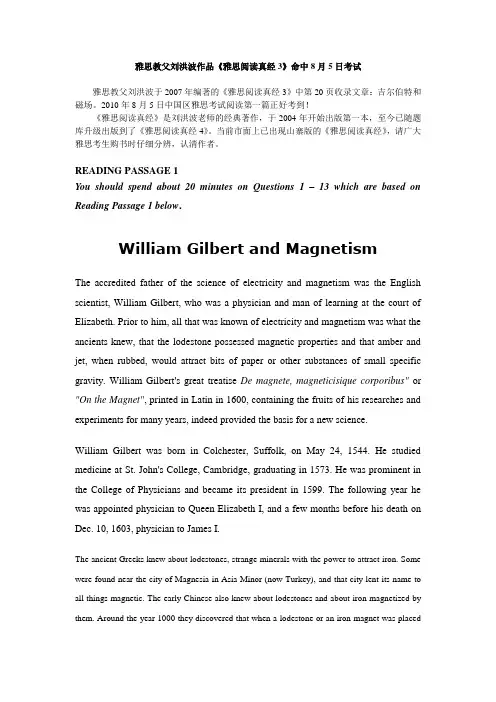
雅思教父刘洪波作品《雅思阅读真经3》命中8月5日考试雅思教父刘洪波于2007年编著的《雅思阅读真经3》中第20页收录文章:吉尔伯特和磁场。
2010年8月5日中国区雅思考试阅读第一篇正好考到!《雅思阅读真经》是刘洪波老师的经典著作,于2004年开始出版第一本,至今已随题库升级出版到了《雅思阅读真经4》。
当前市面上已出现山寨版的《雅思阅读真经》,请广大雅思考生购书时仔细分辨,认清作者。
READING PASSAGE 1You should spend about 20 minutes on Questions 1 –13 which are based on Reading Passage 1 below.William Gilbert and MagnetismThe accredited father of the science of electricity and magnetism was the English scientist, William Gilbert, who was a physician and man of learning at the court of Elizabeth. Prior to him, all that was known of electricity and magnetism was what the ancients knew, that the lodestone possessed magnetic properties and that amber and jet, when rubbed, would attract bits of paper or other substances of small specific gravity. William Gilbert's great treatise De magnete, magneticisique corporibus"or "On the Magnet", printed in Latin in 1600, containing the fruits of his researches and experiments for many years, indeed provided the basis for a new science.William Gilbert was born in Colchester, Suffolk, on May 24, 1544. He studied medicine at St. John's College, Cambridge, graduating in 1573. He was prominent in the College of Physicians and became its president in 1599. The following year he was appointed physician to Queen Elizabeth I, and a few months before his death on Dec. 10, 1603, physician to James I.The ancient Greeks knew about lodestones, strange minerals with the power to attract iron. Some were found near the city of Magnesia in Asia Minor (now Turkey), and that city lent its name to all things magnetic. The early Chinese also knew about lodestones and about iron magnetized by them. Around the year 1000 they discovered that when a lodestone or an iron magnet was placedon a float in a bowl of water, it always pointed south. From this developed the magnetic compass, which quickly spread to the Arabs and from them to Europe.Britain was a major seafaring nation in 1588 when the Spanish Armada was defeated, opening the way to British settlement of America. British ships depended on the magnetic compass, yet no one understood why it worked. Did the pole star attract it, as Columbus once speculated; or was there a magnetic mountain at the pole, as described in Odyssey, which ships should never approach, because the sailors thought its pull would yank out all their iron nails and fittings? Did the smell of garlic interfere with the action of the compass, which is why helmsmen were forbidden to eat it near a ship's compass? For nearly 20 years William Gilbert conducted ingenious experiments to understand magnetism."William Gilbert was fascinated by magnets,” as Dr. David P. Stern of NASA notes. Given two magnets, Gilbert knew that magnetic poles can attract or repel, depending on polarity. In addition, however, ordinary iron is always attracted to a magnet. Gilbert guessed, correctly, that near a permanent magnet iron became a temporary magnet, of a polarity suitable for attraction. That is, the end of an iron bar stuck to an S pole of a magnet (south-seeking pole) temporarily becomes an N-pole. Because magnetic poles always come in matched pairs, the other end of the bar temporarily becomes an S-pole, and can in its turn attract more iron. Gilbert confirmed his guessof temporary ("induced") magnetism by an original experiment. Usingstrings, he hung two parallel iron bars above the pole of a terrella, a modelearth he designed for this experiment, and noted that they repelled each other.Under the influence of the terrella, each became a temporary magnet withthe same polarities, and the temporary poles of each bar repelled those of theother one.In 1600 Gilbert published De magnete in Latin. Very quickly itbecame the standard work throughout Europe on electrical and magnetic phenomena. In this work he describes many of his experiments with his model earth terrella. From his experiments, he concluded that the Earth was itself magnetic and that this was thereason compasses pointed north. In his book, he also studied static electricity using amber. Gilbert strongly argued that electricity and magnetism was not the same thing. For evidence, he (incorrectly) pointed out that electrical attraction disappeared with heat, magnetic attraction did not. By keeping clarity, Gilbert's strong distinction advanced science for nearly 250 years. It took James Clerk Maxwell to show electromagnetism is, in fact, two sides of the same coin.De Magnete is not only a comprehensive review of what was known about the nature of magnetism, Gilbert added much knowledge through his own experiments. He likened the polarity of the magnet to the polarity of the Earth and built an entire magnetic philosophy on this analogy. In Gilbert's animistic explanation, magnetism was the soul of the Earth and a perfectly spherical lodestone, when aligned with the Earth's poles, would spin on its axis, just as the Earth spins on its axis in 24 hours. He speculated that the moon might also be a magnet caused to orbit by its magnetic attraction to the Earth. This was perhaps the first proposal that a force might cause a heavenly orbit.Gilbert did not, however, express an opinion as to whether this rotating Earth was at the center of the universe or in orbit around the Sun. In traditional cosmology the Earth was fixed and it was the sphere of the fixed stars, carrying the other heavens with it, which rotated in 24 hours. Since the Copernican cosmology needed a new physics to under gird it, Copernicans such as Johannes Kepler and Galileo were very interested in Gilbert's magnetic researches. Galileo's efforts to make a truly powerful armed lodestone for his patrons probably date from his reading of Gilbert's book.The first major scientific work produced in England, Gilbert’s De magnete reflected a new attitude toward scientific investigation. Until then, scientific experiments were not in fashion: instead, books relied on quotes of ancient authorities and that is where the myth about garlic interfering with the compass started. Unlike most medieval thinkers, Gilbert was willing to rely on sense experience and his own observationsand experiments rather than the authoritative opinion or deductive philosophy of others. In the treatise he not only collected and reviewed critically older knowledge on the behavior of the magnet and electrified bodies but described his own researches, which he had been conducting for 17 years. It was because of this scientific attitude, together with his contribution to our knowledge of magnetism, that a unit of magneto motive force, also known as magnetic potential, was named the Gilbert in his honor.Questions 1 - 8Do the following statements agree with the information given in Reading Passage 1? In boxes 1 – 8 on your answer sheet write.TRUE FALSE NOT GIVEN if the statement is trueif the statement is falseif the information is not given in the passage1.It was Gilbert who first discovered some substances with magnetic properties.2.Arabs invented the magnetic compass in which an iron magnet always pointedsouth.3.Gilbert explained the phenomenon of the magnetic compass in his book De magnete.4.Gilbert’s mistaken notion about the distinction between electricity and magnetism held backthe development of science.5.Gilbert speculated that the moon orbited the Earth by magnetic force.6.Copernicans such as Galileo favored traditional cosmology which held that the earthwas the center of the universe.7.Gilbert's magnetic theories contradicted the traditional cosmology.8.As a scientist, Gilbert set himself apart by favoring an intuitive approach andexperiments rather than the deductive reason.Questions 9-13Choose the appropriate letters A –D and write them in boxes 9-13on your answer sheet.9. In Odyssey, why could not ships approach the mountain at the pole?A.People believed that they would get lost if garlic hampered the action of the compass.B.People believed that the pole star would distract ships away.C.People believed that the magnetism would wreck the ship.D.People believed that the magnetic mountain would make the compass out ofwork.10. By contacting two metal bars, one magnetized, the other neutral, he was able to pass on a charge to the neutral bar. He called this___________A.induced magnetism.B.permanent magnetism.C.terrella magnetism.D.polar magnetism.11. In De magnete, Gilbert ___________ discussed electricity, magnetism and heat.A.emphaticallyB.scientificallyC.wronglyD.passionately12. James Clerk Maxwell demonstrated that ____________A. electricity and magnetism was the same thing.B. electrical and magnetic attraction disappeared with heat.C. there was some relationship between electricity and magnetism.D. electromagnetism has two opposite sides.13. Gilbert’s De magnete, a collection of his theories and experiments and reflections on others’ work is commonly known as _____________A. an essay.B. a treatise.C. a volume.D. a contribution.。
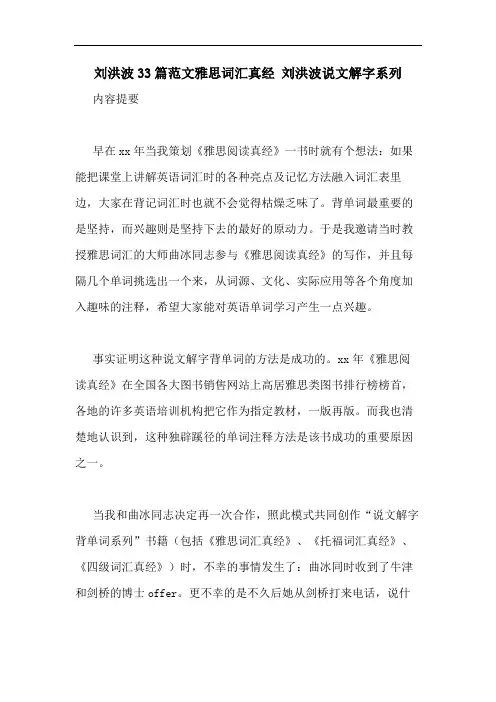
刘洪波33篇范文雅思词汇真经刘洪波说文解字系列内容提要早在xx年当我策划《雅思阅读真经》一书时就有个想法:如果能把课堂上讲解英语词汇时的各种亮点及记忆方法融入词汇表里边,大家在背记词汇时也就不会觉得枯燥乏味了。
背单词最重要的是坚持,而兴趣则是坚持下去的最好的原动力。
于是我邀请当时教授雅思词汇的大师曲冰同志参与《雅思阅读真经》的写作,并且每隔几个单词挑选出一个来,从词源、文化、实际应用等各个角度加入趣味的注释,希望大家能对英语单词学习产生一点兴趣。
事实证明这种说文解字背单词的方法是成功的。
xx年《雅思阅读真经》在全国各大图书销售网站上高居雅思类图书排行榜榜首,各地的许多英语培训机构把它作为指定教材,一版再版。
而我也清楚地认识到,这种独辟蹊径的单词注释方法是该书成功的重要原因之一。
当我和曲冰同志决定再一次合作,照此模式共同创作“说文解字背单词系列”书籍(包括《雅思词汇真经》、《托福词汇真经》、《四级词汇真经》)时,不幸的事情发生了:曲冰同时收到了牛津和剑桥的博士offer。
更不幸的是不久后她从剑桥打来电话,说什么正在闭关研究孔夫子和耶酥基督的异同,而且还thoroughly enjoy,红尘俗事不愿再管。
悲伤啊。
万般无奈,只好一个人在深夜里奋笔疾书。
我坚信付出总是有回报的。
终于有那么一天,英语培训界泰斗人物、北京新航道学校校长胡敏教授被我的黑眼圈所吸引,一番长谈后对本书的创作兴趣颇浓,提出了许多宝贵的写作建议。
之后更不时的从家里搜出一本本泛黄的英语书籍拿来供我参考。
对这些书我从来都是小心翼翼的,不敢用力翻动,怕损毁文物。
得到英语培训界奇才李传伟教授的详细指导也是本书之大幸。
李老时常在百忙之中抽空指点词汇的注释亮点,他在词汇学上的功力让人叹服。
李老本人精通七国语言,对拉丁文、希腊语、西班牙语、法语的领悟使他对英语词汇的把握进入了极高的一种境界。
据说李老在新航道学校考研英语的课堂上偶尔会把各种语言讲窜,同学们大跌眼镜之余纷纷高山仰止。
刘洪波:《IELTS雅思阅读真经4》下面是小编为大家整理带来的《IELTS雅思阅读真经4》,《IELTS 雅思阅读真经4》是《IELTS雅思阅读真经》系列中最新的一册,收录了2008-2009雅思阅读真题,除了依旧保持着题材丰富、真实题库、总结核心词汇的特点,本书还提供了所有文章的中文翻译。
针对前几册没有解析的不足,《IELTS雅思阅读真经4》进行了调整,每一套题目后面都附有难题解析。
目录:一位“不合格”的校长(代序)北京雅思学校西部支教行雅思阅读高分策略雅思阅读真题题库分析TEST 1READING PASSAGE 1:Isambard Kingdom BmnelREADING PASSAGE 2:The Study ofLaughterREADING PASSAGE 3:Shoemaker-Levy 9 Collision with Jupiter核心词汇参考译文参考答案难题解析TEST 2READING PASSAGE 1:Dealing with Different Sleep Patterns READING PASSAGE 2:From Novices to ExpertsREADING PASSAGE 3:The Myth of the Five Senses核心词汇参考译文参考答案难题解析READING PASSAGE 1:TV AddictionREADING PASSAGE 2:Antarctica and Global Warming READING PASSAGE 3:Magnet Therapy核心词汇参考译文参考答案难题解析TEST 4READING PASSAGE 1:Insects and Inspired Artificial Robots READING PASSAGE 2:Extinction ofAussie Animals READING PASSAGE 3:Virtual Reality核心词汇参考译文参考答案难题解析TEST 5READING PASSAGE 1:A Brief History of Rubber READING PASSAGE 2:DesertificationREADING PASSAGE 3:The Legend of Tea核心词汇参考译文参考答案难题解析TEST 6READING PASSAGE 1:A Secbnd Look at Twin Studies READING PASSAGE 2:Torch RelayREADING PASSAGE 3:Hurricane核心词汇参考译文难题解析TEST 7READING PASSAGE 1:Save the TurtlesREADING PASSAGE 2:FearsREADING PASSAGE 3:Warming Climate Causing Biological Changes in the Arctic核心词汇参考译文参考答案难题解析TEST 8READING PASSAGE 1:Water on MarsREADING PASSAGE 2:Choice and HappinessREADING PASSAGE 3:Artist Fingerprints核心词汇参考译文参考答案难题解析TEST 9READING PASSAGE 1:PearlsREADING PASSAGE 2:Saving the Sea CowREADING PASSAGE 3:Transit ofVenus核心词汇参考译文参考答案难题解析TEST 10READING PASSAGE 1:The Origin ofWritingREADING PASSAGE 2:4-day Work WeekREADING PASSAGE 3:New Zealand Algae BiO-diesel核心词汇参考译文参考答案难题解析资料简介:《IELTS雅思阅读真经4》是《IELTS雅思阅读真经》系列中最新的一册,收录了2008-2009雅思阅读真题,除了依旧保持着题材丰富、真实题库、总结核心词汇的特点,本书还提供了所有文章的中文翻译。
《雅思阅读真经》难题解析《雅思阅读真经》,作者刘洪波、曲冰。
自2004年5月面市以来,广大雅思考生好评如潮。
随后2004年5月、6月、7月、8月、9月中国考区所考到的“眼镜蛇毒”、“日本塔”、“古代钱币”、“蝴蝶农场”、“医生受贿”、“校园暴力”、“拯救鲑鱼”等,《真经》里尽可找到相关背景文章和题目。
该书正版市场9月底已售磬,请不要寄钱邮购。
本书再版后将于11月中旬由无忧雅思网首发,敬请关注。
谢谢无忧广大网友的对《雅思阅读真经》的支持。
现把问题解答集中起来,有我和曲冰的解释,也有热心网友的相互解答。
主要是关于TFNG题目思维上的差异。
其他如List of Headings、Matching题型有疑问请仔细重读文章。
————再次感谢大家刘洪波曲冰Enigma Decryptions 难题解析Multiple Choice QuestionsExercise 1:50 Years of British Popular CultureQ7:Presently the most warmly embraced radio station in Britain is BBC Radio 2 because it caters to the general public’s D. nostalgia for the music dominated by the Beatles.问题:Why can't I choose B. nostalgia for the popular music since Queen’s ascension of the throne? As the Queen has been ruling for 50 years, and the text says“nostalgia for the 'pop' music of the last 50 years.”解答:全文最后一句,“怀旧歌曲”指甲壳虫乐队的歌曲,故选D。
刘洪波考研英语词汇真经在线阅读全文共10篇示例,供读者参考篇1Once upon a time, there was a super cool guy named Liu Hongbo. He was like a superhero but for studying English. He wanted to take the super hard test called the GRE, which is like the Olympics for smart people.Liu Hongbo knew he had to study a lot to pass the test, so he decided to read the famous book called "Liu Hongbo's Study Guide to the GRE Online." This book had all the secret tricks and tips to help him pass the test with flying colors.Every day after school, Liu Hongbo would sit down with his computer and read the study guide. He learned about all the different sections of the test – like reading, writing, and math. He also learned how to guess the right answers even if he didn't know the answer for sure.As Liu Hongbo kept reading the study guide, he started to feel more confident about the test. He knew he could do it if he just believed in himself and kept practicing. Finally, the day of thetest arrived, and Liu Hongbo sat down in front of the computer, took a deep breath, and started answering the questions.After a few hours, the test was over, and Liu Hongbo felt proud of himself. He knew he had done his best, thanks to the help of the study guide. A few weeks later, he got the results – he had passed the GRE with flying colors!From that day on, Liu Hongbo became a hero in the world of English study. He proved that with hard work, determination, and a little help from a study guide, anyone can achieve their dreams. And that's the story of Liu Hongbo and his journey to passing the GRE.篇2Hey guys! Today I'm gonna talk about reading the online real scriptures of Liu Hongbo's postgraduate entrance exam English. It's super important to prepare for the postgraduate entrance exam, and one way to do that is by reading Liu Hongbo's materials online.Liu Hongbo's materials are like gold mines full of valuable information and tips for passing the exam. They cover all the key points and provide a lot of examples to help us understandbetter. It's like having a personal tutor right in front of us, guiding us through the exam.When reading Liu Hongbo's materials online, make sure to take notes and practice as much as possible. This will help us remember the important information and improve our English skills at the same time. It's like killing two birds with one stone!Don't forget to also review what you've learned regularly. Repetition is key to mastering any subject, so keep going back to the materials and practicing until you feel confident.In conclusion, reading Liu Hongbo's materials online is a great way to prepare for the postgraduate entrance exam. It's like having a secret weapon that will help us ace the exam and achieve our dreams. So, let's grab those materials and start studying now! Good luck, everyone!篇3Hello everyone! Today I want to tell you about reading the Liu Hongbo's Kao Yan English Vocabulary Online. It is super cool and helpful for studying English!First of all, Liu Hongbo's Kao Yan English Vocabulary Online is like a magic book full of words and phrases. It helps us to learnnew words and remember them easily. The best part is that we can read it online anytime and anywhere. Isn't that awesome?When we read this book, we can improve our English skills step by step. We can learn new words, practice pronunciation, and even understand grammar better. It's like having a super smart teacher right on our computer or phone!One of my favorite things about Liu Hongbo's Kao Yan English Vocabulary Online is that it is fun to read. The stories are interesting and the pictures are colorful. It makes learning English feel like playing a game!So, if you want to become a master of English like Liu Hongbo, make sure to read his Kao Yan English Vocabulary Online. It will help you learn new words, improve your English skills, and have fun at the same time. Don't miss out on this amazing opportunity to level up your English game!篇4Title: Liu Hongbo's Journey of Studying English for Postgraduate Entrance ExamHey guys! Today I want to talk about my big brother Liu Hongbo and his crazy journey of studying English for thepostgraduate entrance exam. So, buckle up and let's dive into the world of English grammar, vocabulary, and reading comprehension!First of all, let me tell you that my brother Liu Hongbo is a total genius when it comes to studying. He can memorize vocabulary like nobody's business and his grammar skills are on point. But English is a tough nut to crack, even for him. That's why he decided to take on the challenge of studying for the postgraduate entrance exam.He started by reading lots of English books and articles every day. He would spend hours on end poring over words and phrases, trying to make sense of them all. It was tough going at first, but he never gave up. He knew that if he wanted to pass the exam, he had to put in the hard work.Next, he focused on improving his grammar skills. He made flashcards of all the different tenses, verb forms, and sentence structures. He would quiz himself every day to make sure he knew them inside and out. It was a lot of work, but he was determined to succeed.Lastly, he tackled the reading comprehension section of the exam. This was perhaps the toughest part for him. He had to read long passages and answer tricky questions about them. Buthe didn't let that stop him. He practiced every day, slowly but surely improving his reading speed and comprehension.In the end, all his hard work paid off. He aced the postgraduate entrance exam and got into his dream school. I couldn't be prouder of my big brother Liu Hongbo and his amazing journey of studying English. He truly is an inspiration to us all.So there you have it, folks. If my brother Liu Hongbo can do it, so can you! Just remember to never give up, keep pushing yourself, and believe in your ability to succeed. Good luck on your own journey of studying English, and who knows, maybe one day you'll be just as successful as Liu Hongbo!篇5Mr. Liu Hongbo is a super cool teacher who helps us little kids with our English studies. He's like a superhero who swoops in with all the answers to our questions. And guess what? He's got this awesome online reading material called the "Liu Hongbo Exam English Vocabulary Online Reading". It's like a treasure trove of words and phrases that can help us become English masterminds!When we click on the website, we're greeted with colorful pictures and fun activities that make learning English feel like a breeze. Mr. Liu Hongbo's online material covers everything from grammar rules to tricky vocabulary words. It's like having a virtual English teacher right at our fingertips!One of the best parts about Mr. Liu's online reading material is that it's so interactive. We can practice our pronunciation, test our comprehension skills, and even play games to make learning English even more fun. And the best part? We can access it anytime, anywhere — whether we're at home or on the go.Thanks to Mr. Liu Hongbo and his amazing online reading material, we're becoming English experts in no time. We're so grateful for his help and can't wait to keep learning more with his awesome resources!篇6Title: Reading Liu Hongbo's Masterpiece for the English ExamHey guys, have you heard of Liu Hongbo's amazing English exam guide online? It's super helpful for all of us struggling with English! Today, let's take a closer look at some of the key points in Liu Hongbo's masterpiece.First of all, Liu Hongbo emphasizes the importance of vocabulary. He suggests that we should learn new words every day and use them in sentences to remember them better. He also recommends reading newspapers, magazines, and books to improve our vocabulary.Next, Liu Hongbo talks about grammar. He says that we should pay attention to grammar rules and practice using them in our writing and speaking. He gives examples of common grammar mistakes and how to avoid them.In addition, Liu Hongbo gives tips on how to improve our reading comprehension skills. He advises us to read different types of texts, such as news articles, essays, and stories. He also recommends taking notes while reading to better understand the main ideas.Furthermore, Liu Hongbo shares his strategies for writing essays. He suggests brainstorming ideas, writing a clear thesis statement, and organizing our thoughts logically. He also gives tips on how to use examples and evidence to support our arguments.Overall, Liu Hongbo's guide is a treasure trove of useful tips and techniques for mastering English. By following his adviceand practicing regularly, we can improve our English skills and ace the exam. Let's all work hard and achieve success together!So, what are you waiting for? Let's start reading Liu Hongbo's masterpiece and conquer the English exam! Good luck, everyone!篇7Title: Reading Liu Hongbo's Online Reading Guide for Postgraduate EnglishHi everyone, do you want to know how to read Liu Hongbo's online reading guide for postgraduate English? Well, I'm here to tell you all about it! Liu Hongbo is a famous teacher who has helped many students pass their postgraduate English exams. His online guide is super helpful and easy to understand.First of all, make sure you have a good grasp of the basics of English grammar and vocabulary. Liu Hongbo's guide covers everything from vocabulary building to sentence structure, so it's important to have a solid foundation before diving in.Next, set aside some time each day to read through the guide and practice the exercises. Remember, practice makesperfect! Liu Hongbo's guide is a great way to improve your English skills and build confidence in your abilities.One of the best things about Liu Hongbo's guide is that it's designed to be interactive and engaging. You can test your knowledge with quizzes, participate in discussions with other students, and even watch video lessons to reinforce your learning.In conclusion, reading Liu Hongbo's online reading guide for postgraduate English is a fantastic way to improve your English skills and prepare for your exams. So what are you waiting for? Start reading today and watch your English improve in no time!篇8Hey guys, today I want to talk about reading Liu Hongbo's online English reading materials for the postgraduate entrance exam. Liu Hongbo is a famous teacher who has helped a lot of students pass their exams, so his materials are super helpful!First of all, reading Liu Hongbo's materials online is really convenient. You can access them anytime and anywhere as long as you have an internet connection. You can read them on your phone, tablet, or computer, which makes studying super easy.Secondly, Liu Hongbo's materials are really well-organized. They cover all the important topics that you need to know for the exam, so you can be sure that you're studying the right things. Plus, the explanations are really clear and easy to understand, so you won't have any trouble grasping the concepts.Lastly, reading Liu Hongbo's materials online is a great way to practice your reading skills. The more you read, the better you'll get at understanding English texts, which is essential for the exam. Plus, you can practice answering questions related to the texts, which will help you prepare for the exam.In conclusion, reading Liu Hongbo's online English reading materials is a great way to prepare for the postgraduate entrance exam. They're convenient, well-organized, and great for practicing your reading skills. So if you're studying for the exam, make sure to check out Liu Hongbo's materials online!篇9Hello everyone, today I want to tell you about reading Liu Hongbo's online reading of GRE English. Liu Hongbo is a famous teacher in China, and he has a lot of experience in helping students study for the GRE exam.First of all, when you read the GRE English materials online, it is important to focus on understanding the main ideas of the passage. Liu Hongbo always emphasizes the importance of grasping the key points and main ideas in order to answer the questions correctly.Secondly, it is important to pay attention to the vocabulary in the passages. Liu Hongbo often provides tips on how to remember and understand new words, which can be very helpful for improving your English skills.In addition, Liu Hongbo's online reading materials cover a wide range of topics, so it is important to be prepared for anything that may come up on the GRE exam. It is a good idea to practice reading different types of passages in order to improve your reading comprehension skills.Overall, reading Liu Hongbo's online materials can be very helpful for improving your English skills and preparing for the GRE exam. Remember to focus on understanding the main ideas, pay attention to vocabulary, and practice reading different types of passages. Good luck with your studies!篇10Once upon a time, there was a super duper smart guy named Liu Hongbo. He wanted to go to a super duper cool school called grad school. But first, he had to pass a super duper hard test called the entrance exam.Liu Hongbo knew he had to study really really hard for the exam. So, he decided to read this super duper famous book called "Liu Hongbo's Graduate School English Exam Bible." It was like the holy grail of study materials!Every day, Liu Hongbo read the book from morning till night. He studied grammar, vocabulary, and reading comprehension like a boss. He even practiced speaking and listening by chatting with his stuffed animals. Yeah, he was that dedicated!Finally, the day of the exam arrived. Liu Hongbo walked into the test room with confidence. He breezed through each section of the exam, thanks to all the hard work he put in. And guess what? He passed with flying colors!Liu Hongbo was over the moon with joy. He thanked the book, his stuffed animals, and most of all, himself for never giving up. From that day on, he was known as the King of the Grad School Entrance Exam.So, kids, the moral of the story is: study hard, believe in yourself, and you can achieve anything you set your mind to. Just like Liu Hongbo did with his super duper awesome English exam bible. The end.。
READING PASSAGE 2You should spend about 20 minutes on questions 14-26,which are based on Reading passage 2 on reading passage 2 on the following pages.Questions14-17Reading passage 2 has five paragraphs A-E.Choose the correct heading for paragraphs B-E from the list of headings below. Write the correct number, I-VII, in boxes 14-17 on your answer sheet.List of HeadingsI Seeking the transmission of radio signals from planetsII Appropriate responses to signals from other civilizationsIII V ast distances to Earth’s closest neighboursIV Assumptions underlying the search for extra-terrestrial intelligenceV Reasons for the search for extra-terrestrial intelligenceVI Knowledge of extra-terrestrial life formsVII Likelihood of life on other planetsExample AnswerParagraph A V14 Paragraph B15 Paragraph C16 Paragraph D17 Paragraph EIS THERE ANYBODY OUT THERE?The Search for Extra-terrestrial IntelligenceThe question of whether we are alone in the universe has haunted humanity for centuries, but we may now stand poised on the brink of the answer to that question, as we search for radio signals from other intelligent civilizations. This search , often known by the acronym SETI (search for extra-terrestrial intelligence), is a difficult one .Although groups around the world have been searching intermittently for three decades, it is only now that we have reached the level of technology where we can make a determined attempt to search all nearby stars for any sign of life.AThe primary reason for the search is basic curiosity-the same curiosity about the natural world that drives all pure science. We want to known whether we are alone in the universe .we want to known whether life evolves naturally if evolves naturally if give the right conditions ,or whether there is something very special about the earth to have fostered the variety of life forms that we see around as on the planet .the simple detection of a radio signal will be sufficient to answer this most basic of all questions .in this sense, SETI is another cog in the machinery of pure science which is continually pushing out the horizon of our knowledge. However, there are other reasons for being interested in whether life exists elsewhere. For example, we have had civlisation on earth for perhaps only a few thousand years, and the threats of nuclear war and pollution over the last few decades have told us that our survival may be tenuous will we last another two thousand years or will we wipe ourselves out? Since the lifetime of a planet like ours is several billion years, we can expect that ,if other civilizations do survive in our galaxy, their ages will range from zero to several billion years. Thus any other civlisation will tell us that long-term survival is possible, and gives us some cause for optimism. It is even possible that the older civilization may pass on the benefits of their experience in dealing with threats to survival such as nuclear war and global pollution, and other thr eats that we haven’t yet discovered.BIn discussing whether we are alone, most SETI scientists adopt two ground rules. First, UFOs(unidentified flying objects) are generally ignored since most scientists don’t consider the evidence for them to be strong enough to bear serious consideration(although it is also important to keep an open mind in case any really convincing evidence emerges in the future). Second, we make a very conservative assumption that we are looking for a life form that is pretty well like us ,since if it differs radically from us we may well not recognise it as a life form, quite apart form whether we are able to communicate with it .in other words, the life form we are looking for may well have two green heads and seven fingers, but it will neverthelessresemble us in that it should communicate with its fellows, be interested in the universe, live on a planet orbiting a star like our sun ,and perhaps most restrictively, have a chemistry like us, based on carbon and water.CEven when we make these assumptions our understanding of other life forms is still severely limited. We do not even know, for example, how many stars have planets, and we certainly do not known how likely it is that life will arise naturally, given the right conditions. However, when we look at the 100 billion stars in our galaxy(the Milky Way),and 100 billion galaxies in the observable universe, it seems inconceivable that at least one of these planets does not have a life form on it ;in fact, the best educated guess we can make, using the little that we do know about the conditions for carbon-based life, leads us to estimate that perhaps one in 100,000 stars might have a life-bearing planet orbiting it. That means that our nearest neighbours are perhaps 100 light years away, which is almost next door in astronomical terms.DAn alien civilization could choose many different ways of sending information across the galaxy, but many of these either require too much energy, or else are severely attenuated while traversing the vast distances across the galaxy. It turns out that, for a given amount of transmitted power, radio waves in the frequency range 1000 to 3000 MHz travel the greatest distance, and so all searches to date have concentrated on looking for radio ways in this frequency range. So far there have been a number of searches by various groups around the word. Including Australian searches using the radio telescope at Parkes, New South Wales. Until now there have not been any detections from the few hundred stars which have been searched. The scale of the searches has been increased dramatically since 1992, when the US Congress voted NASA $10 million per year for ten years to conduct a thorough search for extra-terrestrial life. Much of the money in this project is being spent on developing the special hardware needed to search many frequencies at once. The project has two parts. One part is a targeted search using the world’s largest radio telescopes, the American-operated telescope in Arecibo, Rico and the French telescope in Nancy in France. This part of the project is searching the nearest 1000 likely stars with high sensitivity for signals in the frequency range 1000 to 3000 MHz. The other part of the project is an undirected search which is monitoring all of space with a lower sensitivity, using the smaller antennas of NASA’s Deep Space Network.EThere is considerable debate over how we should react if we detect a signal from an alien civilisation. Everybody agrees that we should not reply immediately. Quite apart from the impracticality of sending a reply over such large distances at short notice, it raises a host of ethical questions that would have to be addressed by the global community before any reply could be sent. Would the human race the culture shock if faced with a superior and much older civilisation? Luckily, there is no urgency aboutthis, The stars being searched are hundreds of light years away, so it takes hundreds of years for their signal to reach us, and a further few hundred years our reply to reach them. It's not important, question of whether to reply, and perhaps carefully drafts a reply.Questions 18-20Answer the questions belowChoose NO MORE THAN THREE WORDS AND/OR A NUMBER from the passage for each answer.Write you answers in boxes 18-20 on your answer sheet.18 What is the life expectancy of Earth?19What kind of signals from other intelligent civilisations are SETI scientists searching for?20How many stars are the world's most powerful radio telescopes searching? Questions 21-26Do the following statements agree with views of the writer in Reading Passage 2?In boxes 21-26 on your answer sheet, writeYES if the statement agrees with the views of the writerNO if the statement contradicts the views of the writerNOT GIVEN if it is impossible to say what the writer thinks about this21Alien civilisations may be able to help the human race to overcome serious problems.22SETI scientists are trying to find a life form that resembles humans in many ways.23The Americans and Australians have co-operated on joint research projects.24So far SETI scientists have picked up radio signals from several stars.25The NASA project attracted criticism from some members of Congress.26 If signal from outer space is received, it will be important to respond promptly.。